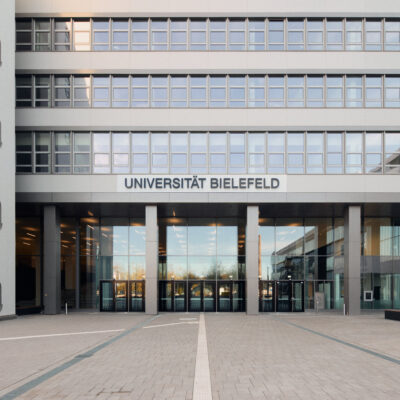Gabi Schierning is an expert on current and heat flow in materials. The European Research Council describes her work as fundamental, visionary research and is funding her to the tune of two million euros. Schierning has been professor of experimental physics at the Faculty of Physics since the 2020/2021 winter semester.
When Gabi Schierning hasn’t understood something, she can’t stop thinking about how to solve it. Even after a day’s work as a professor of experimental physics, she can’t get it out of her head. ‘I talk to myself, and my children ask me if I’m thinking about my research—and usually that’s the case,’ Schierning says. Even though she is in her early 40s, she is also still working through topics from her time as a student. ‘I’ve been carrying some of my questions around with me for years. I find it fascinating to find out how something works.’
Professor Dr Schierning is researching thermoelectrics, the ‘little brother of photovoltaics’, as she puts it. ‘I am investigating how exactly thermoelectric materials generate usable electrical energy.’ In photovoltaics, light is converted into electrical energy; in thermoelectrics, heat is converted into electrical energy and electrical energy into cooling output. The materials scientist is conducting basic research in her field. ‘We know pretty well how a solar cell works; there’s not too much more to find out there. In the field of thermoelectrics, however, things are quite different,’ says Schierning. ‘In the next five years, a great number of new questions may very well emerge in my project.’
At the end of 2019, Schierning was awarded the Consolidator Grant by the European Research Council (ERC). The scientist has been working towards the ERC grant for several years: ‘I first started working on the topic for the ERC in 2016. The conceptual work for the application was arduous and ambitious; the approval of the ERC grant was a huge success.’ The call to Bielefeld University came immediately after the grant was awarded. With two million euros in funding, Schierning is now tackling her big project. It is called MATTER: MAcroscopic quantum Transport maTERials by nanoparticle processing. Schierning and her team are looking at the question: what must the surfaces of thermoelectric materials be like in order to transport electric current efficiently?
Special paths for electric current on surfaces
Thermoelectric materials consist of heavy elements that generate electric current through a temperature difference between the two ends of the material. ‘The electrical energy generated here is not enough to run a power station, but it is optimal for small sensors. Thermoelectrics can also be used to cool computer chips, for example. Temperatures can be controlled precisely,’ says Schierning. For her experiments, she is using, for example, bismuth telluride and antimony telluride.
What concerns the researcher is that these thermoelectric materials are often also topological insulators. Topological insulators do not conduct electricity in their interior, but only at the edge of the material. However, that’s where they conduct it particularly well. The advantage is that the electrical resistance is particularly low here. Electrons can move well in what are known as surface transport channels without scattering. Schierning’s project aims to produce thermoelectric materials with such surface transport channels.
The physicist is getting her nanoparticles for this from a colleague who is a chemist. These tiny nanoparticles are characterized by a high surface-to-volume ratio. Using experimental skills that she has meanwhile perfected, Schierning places electrical contacts on these nanoparticle composites. What fascinates her are the questions that follow: what contribution do the surface transport channels make to electricity generation? How can we measure and further optimize this contribution?
A nose for the practical benefits of fundamental research
Thermoelectrics is a new topic in experimental physics at the university. Other research groups are working on magnetism, for example. ‘We can learn a lot from each other. I am always asking myself how my colleagues’ findings relate to what I’m doing. This always leads to new interfaces for collaboration,’ says Schierning. She considers that building bridges in other directions is obligatory within her field of research: ‘Doing research in an ivory tower is no use to anybody. We have to take our results out into the world, identify interfaces, and remain approachable.’ Even though Schierning is actively engaged in basic research today, she retains a practical approach: ‘I would find it difficult to do research on an exotic material composition for which there is no question of any application.’
Originally, Gabi Schierning wanted to work as an engineer at Siemens after studying materials science at the University of Erlangen-Nuremberg. However, she quickly realized that she wanted to continue with research. After her doctorate, her academic path took her across the country: for six years, she headed a junior research group at the University of Duisburg-Essen; then for five years, a research department at the Leibniz Institute for Solid State and Materials Research Dresden. ‘You can’t plan a research career, and it often means changing your workplace. I am lucky because I always enjoy my work. Now I am happy to be here at Bielefeld University,’ Schierning tells us.
Since the beginning of her career, Schierning has also always enjoyed competing for awards such as the ERC Grant. ‘A proposal is never wasted time. You have to rigorously sort out your own thoughts and work out significant questions. Sometimes I’m in the lead as a researcher; other times I’m behind. If it sometimes doesn’t work out, I always tell myself: keep going, do it better.
This article is a pre-release from „BI.research“, the Bielefeld University research magazine. The new issue will be published soon.





